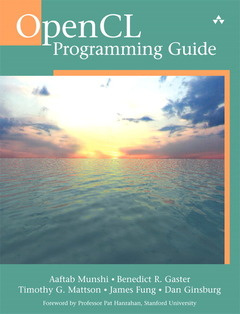OpenCL programming guide
Auteur : MUNSHI Aaftab

Written by five leading OpenCL authorities, OpenCL Programming Guide covers the entire specification. It reviews key use cases, shows how OpenCL can express a wide range of parallel algorithms, and offers complete reference material on both the API and OpenCL C programming language.
Through complete case studies and downloadable code examples, the authors show how to write complex parallel programs that decompose workloads across many different devices. They also present all the essentials of OpenCL software performance optimization, including probing and adapting to hardware. Coverage includes
- Understanding OpenCL's architecture, concepts, terminology, goals, and rationale
- Programming with OpenCL C and the runtime API
- Using buffers, sub-buffers, images, samplers, and events
- Sharing and synchronizing data with OpenGL and Microsoft's Direct3D
- Simplifying development with the C++ Wrapper API
- Using OpenCL Embedded Profiles to support devices ranging from cellphones to supercomputer nodes
- Case studies dealing with physics simulation image and signal processing, such as image histograms, edge detection filters, Fast Fourier Transforms, and optical flow math libraries, such as matrix multiplication and high-performance sparse matrix multiplication and more
Tables xxi
Listings xxv
Foreword xxix
Preface xxxiii
Acknowledgments xli
About the Authors xliii
Part I: The OpenCL 1.1 Language and API 1
Chapter 1: An Introduction to OpenCL 3
What Is OpenCL, or . . . Why You Need This Book 3
Our Many-Core Future: Heterogeneous Platforms 4
Software in a Many-Core World 7
Conceptual Foundations of OpenCL 11
OpenCL and Graphics 29
The Contents of OpenCL 30
The Embedded Profile 35
Learning OpenCL 36
Chapter 2: HelloWorld: An OpenCL Example 39
Building the Examples 40
HelloWorld Example 45
Checking for Errors in OpenCL 57
Chapter 3: Platforms, Contexts, and Devices 63
OpenCL Platforms 63
OpenCL Devices 68
OpenCL Contexts 83
Chapter 4: Programming with OpenCL C 97
Writing a Data-Parallel Kernel Using OpenCL C 97
Scalar Data Types 99
Vector Data Types 102
Other Data Types 108
Derived Types 109
Implicit Type Conversions 110
Explicit Casts 116
Explicit Conversions 117
Reinterpreting Data as Another Type 121
Vector Operators 123
Qualifiers 133
Keywords 141
Preprocessor Directives and Macros 141
Restrictions 146
Chapter 5: OpenCL C Built-In Functions 149
Work-Item Functions 150
Math Functions 153
Integer Functions 168
Common Functions 172
Geometric Functions 175
Relational Functions 175
Vector Data Load and Store Functions 181
Synchronization Functions 190
Async Copy and Prefetch Functions 191
Atomic Functions 195
Miscellaneous Vector Functions 199
Image Read and Write Functions 201
Chapter 6: Programs and Kernels 217
Program and Kernel Object Overview 217
Program Objects 218
Kernel Objects 237
Chapter 7: Buffers and Sub-Buffers 247
Memory Objects, Buffers, and Sub-Buffers Overview 247
Creating Buffers and Sub-Buffers 249
Querying Buffers and Sub-Buffers 257
Reading, Writing, and Copying Buffers and Sub-Buffers 259
Mapping Buffers and Sub-Buffers 276
Chapter 8: Images and Samplers 281
Image and Sampler Object Overview 281
Creating Image Objects 283
Creating Sampler Objects 292
OpenCL C Functions for Working with Images 295
Transferring Image Objects 299
Chapter 9: Events 309
Commands, Queues, and Events Overview 309
Events and Command-Queues 311
Event Objects 317
Generating Events on the Host 321
Events Impacting Execution on the Host 322
Using Events for Profiling 327
Events Inside Kernels 332
Events from Outside OpenCL 333
Chapter 10: Interoperability with OpenGL 335
OpenCL/OpenGL Sharing Overview 335
Querying for the OpenGL Sharing Extension 336
Initializing an OpenCL Context for OpenGL Interoperability 338
Creating OpenCL Buffers from OpenGL Buffers 339
Creating OpenCL Image Objects from OpenGL Textures 344
Querying Information about OpenGL Objects 347
Synchronization between OpenGL and OpenCL 348
Chapter 11: Interoperability with Direct3D 353
Direct3D/OpenCL Sharing Overview 353
Initializing an OpenCL Context for Direct3D Interoperability 354
Creating OpenCL Memory Objects fro
Date de parution : 08-2011
Ouvrage de 603 p.
Disponible chez l'éditeur (délai d'approvisionnement : 14 jours).
Prix indicatif 58,24 €
Ajouter au panier


